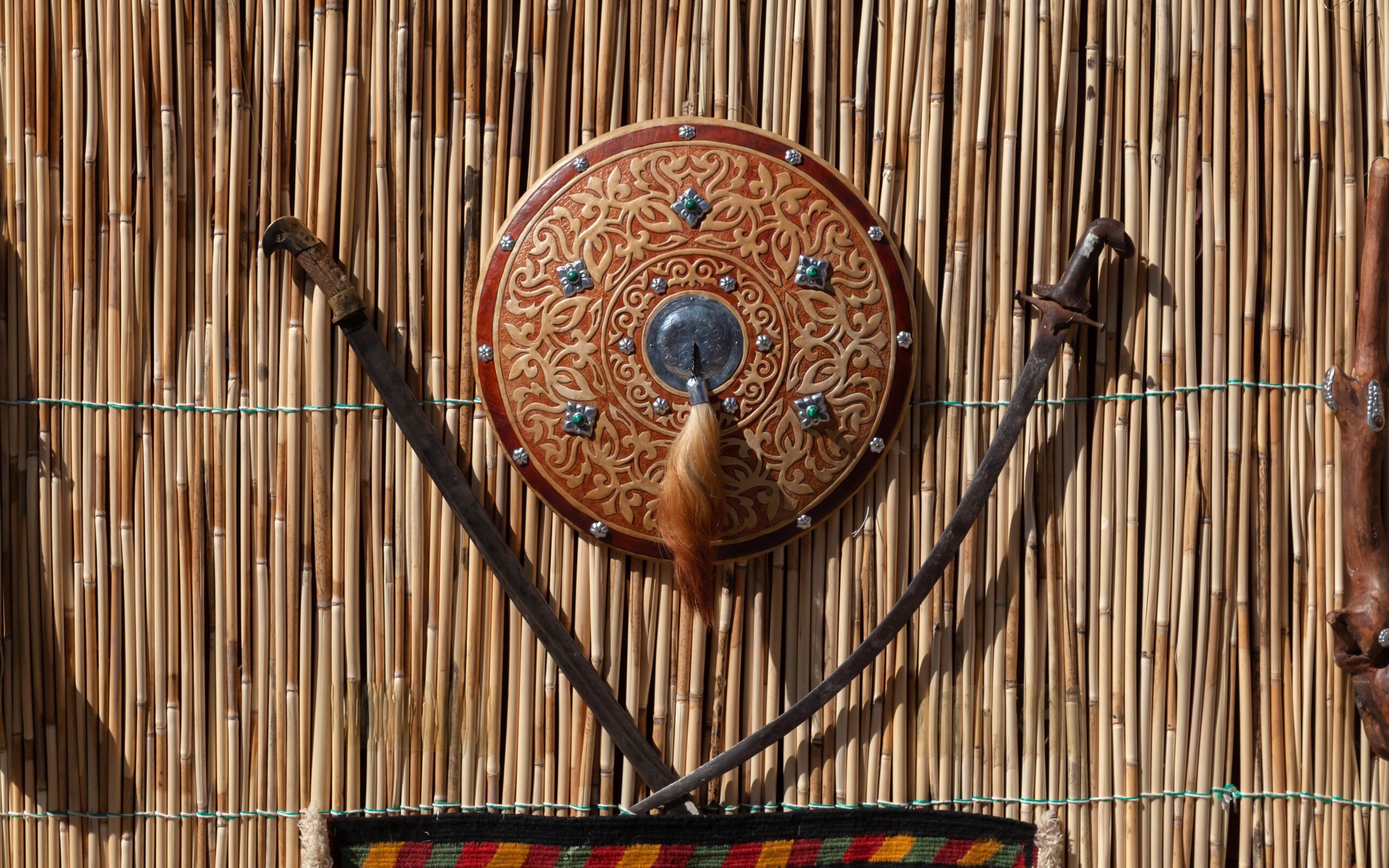Copyright astanatimes

ASTANA – Weapons played a vital role in the life of nomadic peoples, serving not only in battle but also in rituals, social ceremonies, divination, oaths, and as symbols of power and status. They were used as rewards and even as payment for military service. Artist, ethnographer, and weapons expert Kaliolla Akhmetzhan, a member of the Union of Artists and the Academy of Arts of Kazakhstan and a Ph.D. in history, spoke with Kazinform about Kazakh traditions of weaponry, its symbolism, production centers, and the women warriors whose courage stretches back to ancient times. According to Akhmetzhan, Kazakh warriors, known as batyrs, mastered five main categories of weapons, each serving a specific purpose. The first type was projectile weaponry, used for long-range attacks, primarily bows and arrows, later replaced by firearms. The other four were melee weapons for close combat: cutting and thrusting, slashing, blunt-force, and piercing weapons. Each type had several variations. Cutting and thrusting weapons included the saber (kylysh), sword (semser), and shashka (sapy). Piercing weapons included the spear (naiza), pike (sunggy), and throwing spear (zhyda). Blunt-force weapons featured the mace (shokpar), club (kurzi), and flail (bosmoyin shokpar). Slashing weapons included the battle axe (balta), poleaxe (aibalta), and hatchet (baltashyk). “All differed in form, construction, and purpose. Batyrs were expected to wield all five kinds of weapons proficiently,” Akhmetzhan said. By the 15th century, bows, the main projectile weapon of nomads, began to give way to firearms. The evolution of weaponry Akhmetzhan noted that across eras, the design of these weapons evolved. During the Saka period, short swords known as akinakes were common, later replaced by longer blades. In the Turkic period, straight swords gradually evolved into curved sabers – the signature weapon of nomads. Maces and axes also changed form, while spearheads varied depending on function and era. “Historically, these five types of weapons emerged in the mid-first millennium B.C. and remained the core of nomadic armament until the 19th century, though their forms evolved,” Akhmetzhan said. For nomads, the bow and arrow were primary weapons. Ancient Persian sources mention that Persian princes were sent to the Saka to learn archery. The medieval Arab historian al-Jahiz wrote: “The Turks are the best archers in the world, as if they have four eyes, two in front and two behind, and they can shoot in all directions. While an Arab releases one arrow, a Turk releases four.” Kazakhs, too, were celebrated for their skill with the bow and rifle. The best archers were called mergens. During battle, they acted much like modern snipers, targeting enemy leaders and commanders. Kazakh epics often praise such archers. One hero, Batyr Yespembet, who fought in the Kazakh-Dzungar wars, was renowned for his precision. According to legend, he once shot down a Kalmyk girl’s headscarf from the peak of Mount Okzhetpes, a feat no one else could achieve. Under Ablai Khan, elite mergen units were tasked with eliminating the most dangerous foes. “The saber was the second most common weapon, wielded with remarkable skill. Kazakh warriors were also adept with axes – European travelers noted their unmatched agility in close combat,” Akhmetzhan said. “Kazakh warriors mastered every kind of weapon. Their skill, courage, and devotion to their homeland allowed them to preserve vast territories. We, their descendants, have every reason to be proud,” he added. Nomadic vs. sedentary weapons According to Akhmetzhan, nomadic weapons and armor were lighter and more mobile, designed for horseback combat. Sabers and swords were smaller than those of sedentary peoples, and armor was flexible rather than bulky. Chainmail and lamellar armor, made of overlapping metal plates, provided both strength and mobility. “Shields were small and light, typically round or rectangular, about 60 to 70 centimeters in diameter. They were used not to absorb blows but to deflect them, unlike the large, heavy wooden shields of sedentary armies,” he said. Chainmail, believed to have originated among nomads, resembled a shirt of interlinked rings, allowing free movement while offering strong protection. Helmets, arm guards, and greaves protected the warrior without restricting mobility. Firearms among the Kazakhs Written and oral sources indicate that firearms appeared among Kazakhs in the 15th century during the decline of the Golden Horde and the rise of the Kazakh Khanate. “One of the earliest examples was the Battle of Orbulak, where Sultan Zhangir held off a much larger Dzungar army with just 600 riflemen using firearms,” Akhmetzhan said. By the 18th century, Russian archival records noted widespread firearm use among Kazakhs. Reports from Orenburg officials in 1744 and 1759 stated that the middle and junior zhuzes (the Kazakh tribes) could muster 30,000 to 60,000 riflemen, a formidable force at the time. Early guns were matchlock rifles, later replaced by flintlocks and, by the 19th century, pistols and shortened rifles designed for horsemen. Centers of weapon production Nomadic rulers typically maintained royal armories known as karhana (from Persian kar, meaning weapon). During the Golden Horde, they were called zhebekhane. Kazakh blacksmiths were famed for their skill, forging not only jewelry and tools but also axes, sabers, and spears. “Some weapons were imported from world centers of high-quality production, while others were obtained as war trophies. Kazakh gunsmiths often bought Iranian blades and crafted the rest – the hilt, scabbard, and ornamentation – themselves. Sometimes they purchased only the barrel and made the remaining parts locally,” Akhmetzhan said. Written sources, such as those by Ruzbekhan, note that during Burunduk Khan’s reign, Kazakh artisans preserved the armory traditions of the Golden Horde until wars with the Shaybanids destroyed many workshops. The sacred meaning of weapons Akhmetzhan noted that for nomadic peoples, weapons held sacred meaning, symbolizing life, protection, and tribal survival. Herodotus wrote that the Scythians placed swords on burial mounds and offered sacrifices to them. The Saka believed weapons ward off evil spirits. Among Kazakhs, it was customary to place a knife under a sick child’s pillow or a saber by the bedside for protection. “Weapons also carried social and diplomatic meaning. They were exchanged as gifts, used in treaties, and symbolized rank or authority. A general might receive a saber or mace as a sign of command. The quality of a weapon reflected the level of relations between the parties,” he said. When a khan was enthroned, he was girded with a sword, a ritual symbolizing his duty to defend the realm. Under Russian rule, this tradition continued during the formal recognition of Kazakh khans. Weapons also played roles in rituals and oaths. People swore on rifles or swords, believing false oaths would bring divine punishment. In blood-brotherhood ceremonies, warriors mixed their blood with a sword before drinking it together. Weapons were also given as rewards and offered as compensation, underscoring their enduring social and symbolic value. Women warriors of the steppe “Women also took up arms among nomadic peoples. The most famous was Queen Tomiris, who defeated Cyrus the Great of Persia. Epic tales across Central Asia celebrate women warriors, such as the Karakalpak ‘Kyryk Kyz’ [Forty Girls] and Saikal from the Kyrgyz epic ‘Manas,’ who triumphed in ritual combat,” Akhmetzhan said. He mentioned a heroic tale about Kaztugan Batyr’s daughter, who set out to avenge her slain father, as she had no brothers to do so. Before granting her blessing, the mother tested her daughter’s skill by tossing five sheep pellets into the air. The girl struck each one with her spear before they hit the ground. “This shows that such spear training was probably common. The mother and daughter, both descended from a batyr family, mastered the technique,” he said. During the Kazakh-Dzungar wars, women such as Gaukhar, the sister of Malaisary Batyr and wife of Kabanbai Batyr, fought alongside men. Bopai Khanum, sister of Kenessary Khan, led a detachment of 600 warriors. This tradition continued into the 20th century with Aliya Moldagulova and Manshuk Mametova, heroines of the Second World War. Their courage reflects the enduring legacy of women warriors in Kazakh culture. The article was originally published in Kazinform.



